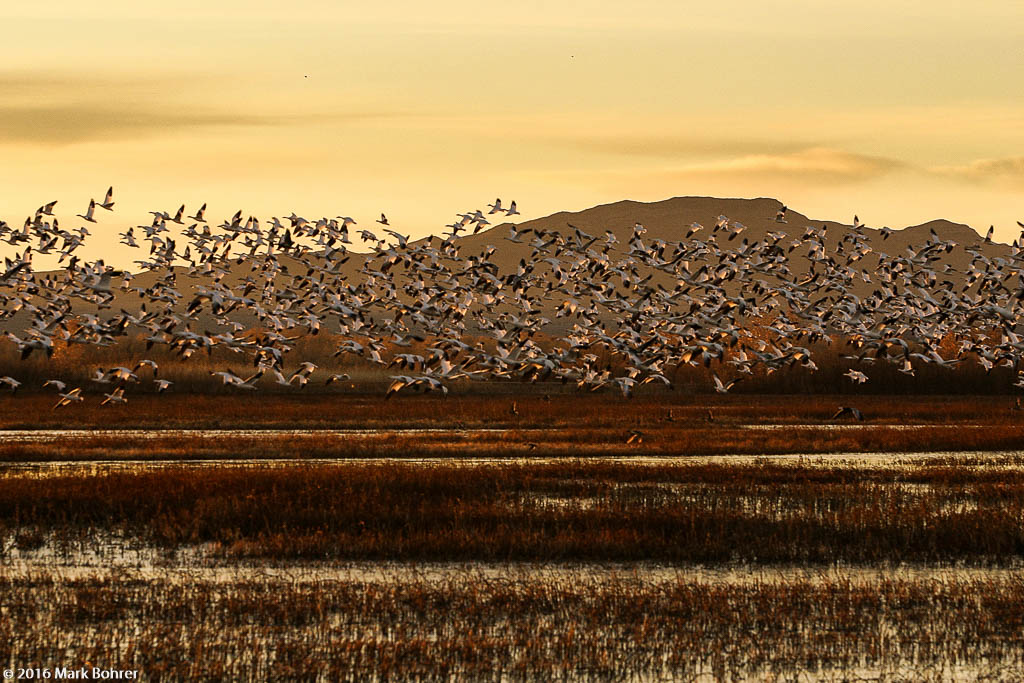|
Early Morning… Rain Your alarm goes off at 4:30 am. You hop out of bed, excited to shoot in some great morning light – sunrise is in two hours, so you have plenty of time to get to the site and set up. But looking outside, it’s raining. Is it time to go back to bed? Everything’s Better With Weather Featureless sky is boring. The California coast gives you relentless plain blue between May and October. There’s usually some color at the beginning and end of the day, but otherwise, featureless sky backgrounds suck. When a storm’s coming or going, you’ll get great cloud textures with clouds and an extension of your shooting day towards noon from both ends. Light will be less contrasty, softer. Shadow detail will show up with little to no post-processing, and you’ll get selective lighting almost like a spotlight through cloud breaks. (If you’re lucky, that lighting will be on a feature you want to highlight.)  Snow goose dawn liftoff, Bosque Del Apache NWR, New Mexico Chaco Experience We got lucky on a recent trip to Chaco Canyon. A storm system was just starting to clear, so the rain was pretty much over, but cloud textures were spectacular. On the road in, I stopped for some establishing and insurance shots, to make sure I got to capture at least some of the cloud cover and great light on the landscape. But when I got there, I saw I shouldn’t have worried – it was ‘impossible to shoot a bad picture’ light on the ruins. With low clouds on the horizon, backgrounds were perfect. Those same clouds covered the sun and softened its light. Sometimes when the sun peeped through cloud breaks, I got spotlight shafts on pieces of ruins. This added depth to the ruins through soft shadows.  Pueblo Bonito, Chaco Canyon, New Mexico Use Weather-Sealed Gear Recent advanced-amateur / semi-pro cameras feature fairly effective weather sealing. To use them, you’ll also need weather-sealed lenses. This excludes the otherwise excellent kit lenses you get with entry-level dSLRs like the Canon Rebel series. Use a kit lens with an entry-level dSLR in rain or wind and dust, and both will stop working. You’ll also end up with a not-so-nice repair bill.  American brown pelican, Ano Nuevo, California Nikon’s original VR Zoom-Nikkor 80-400mm f/4.5-5.6 ED would always require service after I tried to use it in the rain at pro mountain bike races. That lens did not like even light precip, though the D1H dSLR I used it with was always fine.  2006 Sea Otter Classic – Men’s Cross-Country, Laguna Seca, California I’ve used Canon’s EOS 1D mk II with EF 400mm f/4 DO IS and EF 500mm f/4L IS lenses in the rain. I had no trouble going ‘barefoot’ with this pro-level equipment. I’ve also used Canon’s EOS 5D mk II and EOS 7D with EF 24-70mm f/2.8L and EF 70-200mm f/2.8L IS lenses in mud and rain at pro mountain bike races. None of this uncovered gear gave me trouble, either. Cover It I’ve also used AquaTech’s SportShield and matching eyepiece to cover camera and 500mm lens in drippy mountain weather. The SportShield worked well, though it adds an extra level of difficulty to using a camera. I could have gone with an Op/Tech rainsleeve for a lot less money, or even a big ZipLock bag. But I figured for gear worth a few thousand dollars, I could spend a bit more on rain protection for those times when I really need it. It’s cheap insurance in a downpour, when I’m capturing shots nobody else gets. |
(408) 483-3782
Curious about how to shoot ruins?(408) 483-3782

Recent Comments